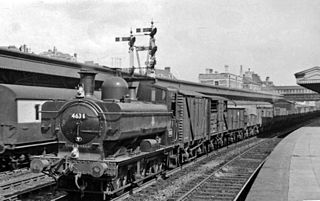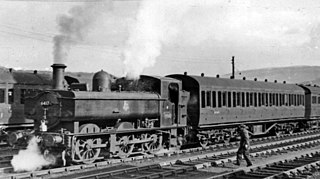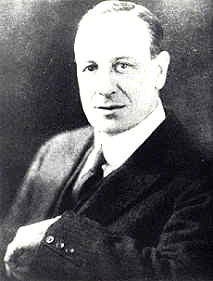
A tank locomotive or tank engine is a steam locomotive that carries its water in one or more on-board water tanks, instead of a more traditional tender. Most tank engines also have bunkers to hold fuel; in a tender-tank locomotive a tender holds some or all of the fuel, and may hold some water also.

The first Locomotives of the Great Western Railway (GWR) were specified by Isambard Kingdom Brunel but Daniel Gooch was soon appointed as the railway's Locomotive Superintendent. He designed several different 7 ft 1⁄4 in broad gauge types for the growing railway, such as the Firefly and later Iron Duke Class 2-2-2s. In 1864 Gooch was succeeded by Joseph Armstrong who brought his standard gauge experience to the workshops at Swindon. To replace some of the earlier locomotives, he put broad gauge wheels on his standard gauge locomotives and from this time on all locomotives were given numbers, including the broad gauge ones that had previously carried just names.

The Great Western Railway 3200 Class was a design of 4-4-0 steam locomotive for passenger train work. The nickname for this class, almost universally used at the time these engines were in service was Dukedog since the locomotives were composed of former Duke Class boilers on Bulldog Class frames. As such they were one of the last standard gauge steam locomotive classes to retain outside frames.

The GWR 5700 Class, or 57xx class, is a class of 0-6-0 pannier tank steam locomotive built by the Great Western Railway (GWR) and British Railways (BR) between 1929 and 1950. With 863 built, they were the most prolific class of the GWR, and one of the most numerous classes of British steam locomotive.

The Great Western Railway (GWR) 2251 Class or Collett Goods Class was a class of 0-6-0 steam tender locomotives designed for medium-powered freight. They were introduced in 1930 as a replacement for the earlier Dean Goods 0-6-0s and were built up to 1948.

The GWR 1400 Class is a class of steam locomotive designed by the Great Western Railway for branch line passenger work. It was originally classified as the 4800 Class when introduced in 1932, and renumbered in 1946.

The Great Western Railway (GWR) 1500 Class is a class of 0-6-0 pannier tank steam locomotive. Despite being a GWR Hawksworth design, all ten were completed under the administration of the Western Region of British Railways in 1949, just after Nationalisation.

The Great Western Railway (GWR) 1366 Class was a class of 0-6-0 pannier tank steam locomotives built in 1934. They were a useful design and because of their light weight and short wheelbase and were often used on dockside branches or other lines with sharp curvatures.

The GWR 5600 Class is a class of 0-6-2T steam locomotive built between 1924 and 1928. They were designed by Charles Collett for the Great Western Railway (GWR), and were introduced into traffic in 1924. After the 1923 grouping, Swindon inherited a large and variable collection of locomotives from historic Welsh railway companies, which did not fit into their standardisation programme. GWR boiler inspectors arrived en masse and either condemned the original locomotives or had them rebuilt. The systematic destruction of many examples of locomotives, most still in serviceable condition, followed, but various were worked alongside 5600 Class.

The Great Western Railway (GWR) 5400 Class was a class of 0-6-0 pannier tank steam locomotive. They were similar in appearance to many other GWR tank engines but smaller than the ubiquitous GWR 5700 Class.

The Great Western Railway (GWR) 6400 Class is a class of 0-6-0 pannier tank steam locomotive introduced by Charles Collett in 1932. All 40 examples were 'auto-fitted' – equipped with the remote-control equipment needed for working autotrains.

Charles Benjamin Collett was Chief Mechanical Engineer of the Great Western Railway from 1922 to 1941. He designed the GWR's 4-6-0 Castle and King Class express passenger locomotives.

Frederick William Hawksworth, was the last Chief Mechanical Engineer of the Great Western Railway (GWR).
The GWR 0-6-0PT, is a type of steam locomotive built by the British Great Western Railway with the water tanks carried on both sides of the boiler, in the manner of panniers. They were used for local, suburban and branch line passenger and goods traffic, for shunting duties, and as banker engines on inclines. The early examples, such as the 1901 and 2021 classes, were rebuilt from saddle or side tanks when the locos received a Belpaire firebox – this type of firebox has a square top and is incompatible with a curved saddle tank. This process mostly took place during the tenure at Swindon Works of George Jackson Churchward. Only a very small number of saddle tank locomotives escaped rebuilding as panniers, notably the 1361 Class built new under Churchward in 1910, by which date a few of the 1813 Class had already been rebuilt as pannier tanks.

The GWR 2021 Class was a class of 140 0-6-0ST steam locomotives. They were built at the Wolverhampton railway works of the Great Western Railway between 1897 and 1905. 1897 was the very year of George Armstrong's retirement, so it is uncertain if the design should be attributed to him or to his superior at Swindon, William Dean.
The GWR 2721 Class was a class of 0-6-0ST steam locomotives. They were designed by William Dean and built at the Swindon Works of the Great Western Railway between 1897 and 1901.

The GWR Class 850 was an extensive class of small 0-6-0ST locomotives designed by George Armstrong and built at the Wolverhampton railway works of the Great Western Railway between 1874 and 1895. Aptly described as the GWR equivalent of the LB&SCR "Terrier" Class of William Stroudley, their wide availability and lively performance gave them long lives, and eventually they were replaced from 1949 by what were in essence very similar locomotives, the short-lived 1600 Class of Frederick Hawksworth, which in the headlong abandonment of steam outlived them by a mere seven years or so.
The 1016 Class consisted of sixty double framed 0-6-0ST locomotives designed by George Armstrong and built at the Wolverhampton Works of the Great Western Railway between 1867 and 1871. Like the earlier 302 Class of Joseph Armstrong, the 1016s had 4 ft 6 in (1.372 m) wheels and a 15 ft 6 in (4.72 m) wheelbase, dimensions that would remain traditional for the larger GWR pannier tanks right through to Charles Collett's 5700 Class, and with little change to Frederick Hawksworth's 9400 Class of 1947.
The GWR 1854 Class was a class of 0-6-0T steam locomotives designed by William Dean and constructed at the Swindon Works of the Great Western Railway. The class used similar inside frames and chassis dimensions to the 1813 Class of 1882-4. In this they differed from the intervening 1661 Class, which had reverted to the double frames of the Armstrong era. Thus the 1854 Class belongs to the "mainstream" of GWR 0-6-0T classes that leads towards the larger GWR pannier tanks of the 20th century.





















